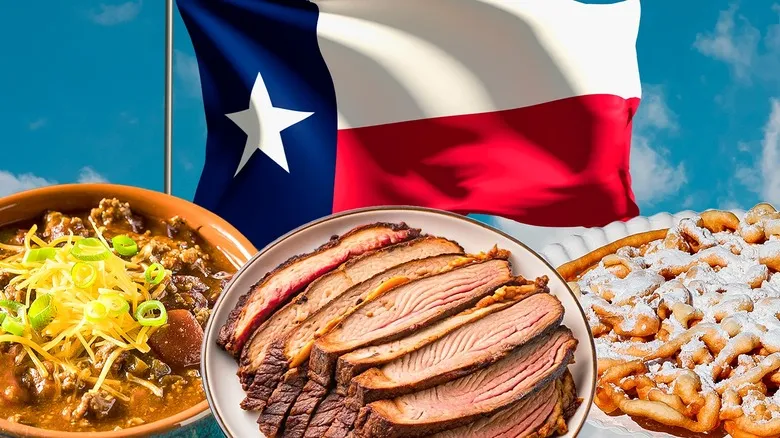Beef brisket
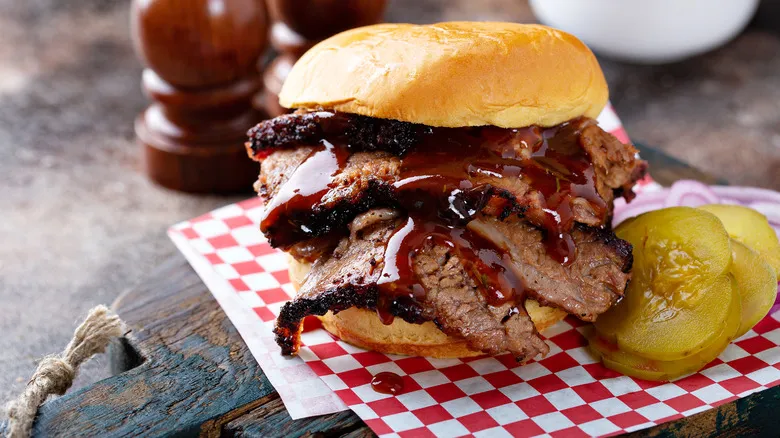
Like many beloved dishes from Texas, brisket arrived in the Lone Star State through the influence of immigrants. As Texas Monthly highlights, this tender, smoky meat gained popularity among Eastern Europeans, especially Jewish settlers, because of its kosher cut and its capacity to serve large gatherings. With Texas' rich cattle industry, the state became an ideal location for making brisket accessible to everyone.
The allure of Texas brisket goes beyond its delectable taste—achieved by slow-smoking the meat for hours at low temperatures—it also embodies a sense of community. In Texas, barbecue is more than just a meal; it’s a social occasion. Families, friends, and neighbors come together around smokers, eagerly awaiting the brisket to reach its peak. While it is possible to smoke brisket indoors, the shared excitement, coupled with the enticing aroma of smoked post oak or mesquite, is an integral part of the experience, just as important as the food itself. This is why people wait in long lines at the famous Franklin BBQ in Austin, why 5,000 visitors flock to Lockhart, Texas barbecue spots each week, and why Texas A&M includes Brisket Camp in its Meat Science curriculum.
Traditional Texas brisket is typically seasoned with just salt and pepper, allowing the natural flavors of the beef and smoke to take center stage. However, other spice blends, like those found in barbecue brisket and cowboy butter recipes, can enhance the flavor as well. Enjoy it with simple sides such as coleslaw, pickles, and a slice of white bread, or pile it onto a soft, buttery bun with barbecue sauce.
Chili con carne
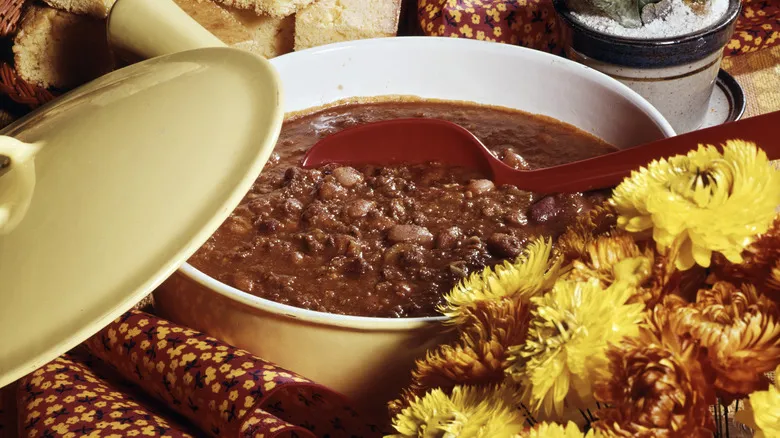
Texas chili, also known as chili con carne, has held the title of the state's official dish since 1977, making it even more legendary than barbecue! What contributes to its unforgettable nature? Like many dishes from Texas, the emphasis is on the meat. The debate over whether to include beans in chili is hotter than a ghost pepper, but Texans have made their stance clear: No beans in these bowls.
For the purists, beans compromise the flavor and detract from the main attraction: the beef (after all, this is the Beef State). Texas chili is characterized by generous portions of meat—typically tougher, well-marbled cuts that tenderize over time, such as chuck—combined with a blend of spices like cumin, garlic, and occasionally cinnamon or cocoa for extra richness. Tomatoes or tomato paste are often included, and the heat comes from a variety of chili peppers that vary with each recipe. The end result is a robust bowl of tender beef infused with a rich, smoky flavor.
The origins of Texas chili are a matter of debate, with theories suggesting influences from Spanish settlers, Mexican cowboys in the 1800s, Indigenous Americans, and Canary Island immigrants. Nevertheless, the meat-centric version, like this chili con carne recipe, became a beloved staple at the "Chili Queens" stands in San Antonio during the late 19th and early 20th centuries, where vendors served hot bowls to both locals and visitors. Today, Texans honor their unique version at family gatherings and cook-offs, with the first state competition taking place at the 1952 Texas State Fair.
King Ranch casserole
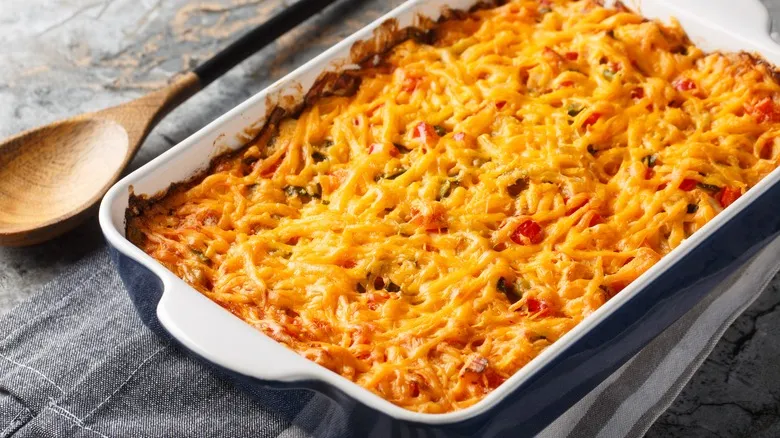
This rich, cheesy, and slightly spicy dish embodies comfort, taste, and ease. Named after the largest ranch in the United States, King Ranch casserole resembles a Tex-Mex lasagna, created by layering corn tortillas, shredded chicken, a savory sauce, and an abundance of cheese. The sauce typically features a blend of canned cream of mushroom and cream of chicken soups, Ro-Tel tomatoes, and a hint of chili powder for that signature Tex-Mex flair.
With its hearty components and straightforward preparation, this dish is a favorite at potlucks and family gatherings. Simply layer the ingredients in a casserole dish, pop it in the oven, and you have a delicious meal ready to serve. You can easily personalize it by adding extras like bell peppers, onions, or jalapeños, and even scale up the recipe effortlessly.
The true origins of King Ranch Casserole remain somewhat mysterious. Despite its name, it likely didn't originate on the King Ranch, known for its beef, and the King family has not claimed the dish. It’s more probable that inventive home cooks in the 1940s or '50s created it, taking advantage of the convenience of canned soups. Regardless of its origins, King Ranch casserole has secured its place in Texas culinary lore, celebrated for its bold flavors, generous portions, and hassle-free, crowd-pleasing nature. Ready to try it out? Begin with this easy from-scratch recipe!
Chicken-fried steak
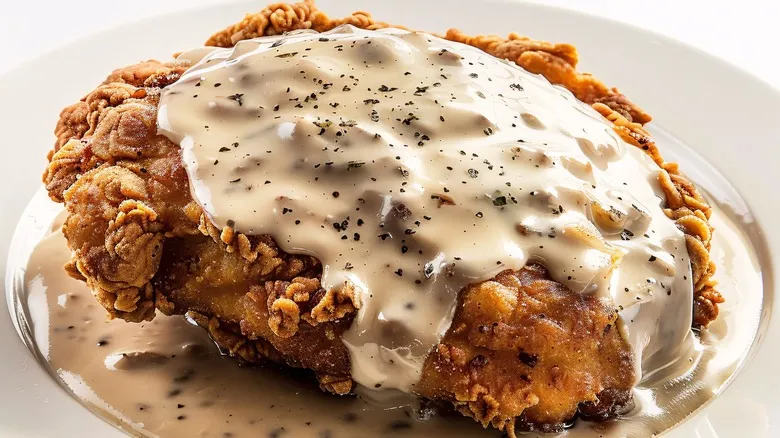
Despite its name, this dish contains no chicken — just a tenderized beef steak, typically a cost-effective cut like cube steak, that is floured or battered and fried to achieve a crispy, golden exterior, reminiscent of fried chicken. This hearty meal is often drenched in a creamy, peppery white gravy and commonly paired with mashed potatoes or buttery biscuits (or green beans or corn if you're feeling adventurous). The result is a dish that is substantial, comforting, and unapologetically indulgent, much like Texas itself.
There’s some discussion about the origins of chicken fried steak. One popular tale, highlighted in Food Timeline, claims it originated from a mishap in 1911 when a short-order cook in Lamesa, Texas, mistakenly battered and fried a steak instead of chicken. Although this story has been debunked, it hasn’t stopped Lamesa from declaring itself the "Legendary Home of the Chicken-Fried Steak" and hosting an annual festival to celebrate its creation. Other accounts suggest that German and Austrian immigrants may have influenced the dish by introducing their traditional breaded cutlets to Texas, which home cooks later adapted.
Regardless of its beginnings, chicken fried steak has become a beloved staple in diners, cafes, and family kitchens across Texas. Texans have even elevated their affection for the dish by officially designating October 26 as Chicken Fried Steak Day. Want to recreate that diner-style experience at home? Try making this classic chicken-fried steak!
Breakfast tacos
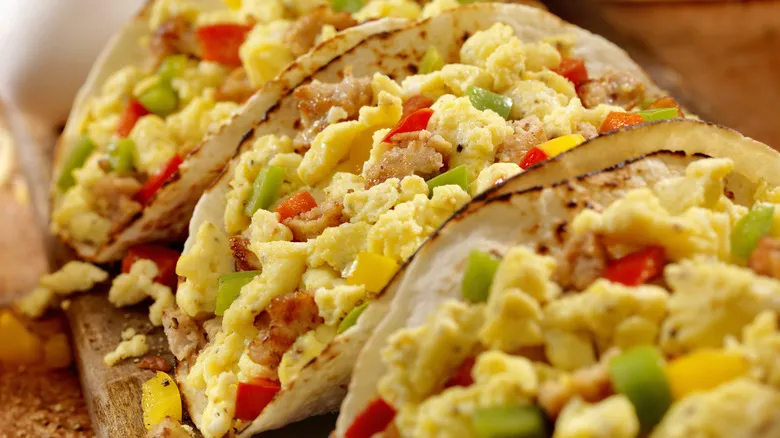
Forget about bacon and eggs, folks — breakfast tacos are the real champions' breakfast in Texas. Imagine a soft, warm tortilla filled with scrambled eggs, cheese, and any toppings you desire — crispy bacon, spicy chorizo, sautéed vegetables, creamy avocado, or refried beans. Add a sprinkle of cheese, a dollop of salsa, and perhaps a splash of hot sauce, and you've got a breakfast that delivers a flavorful punch all in one convenient, portable package. They're like mini breakfast burritos but quicker and arguably more delicious.
Breakfast tacos have their roots in northern Mexico, drawing inspiration from dishes in Monterrey and beyond. However, the origin of the term "breakfast tacos" has sparked a lively debate, with both Austin and San Antonio claiming the title. Despite their current popularity, breakfast tacos weren't always well-received, at least according to Austin's history. Decades ago, the segregation of Mexican families and restaurants in Austin made enjoying tacos a source of ridicule or even shame. But as Texas' culinary landscape evolved, tacos transformed from being scorned to becoming a cherished staple throughout the state.
Whether you grab them from a well-known taco chain like Torchy's or Tacodeli, a local taco truck, a coffee shop, or even a gas station, breakfast tacos are now ubiquitous and show no signs of losing their appeal. You can also whip up a batch at home with whatever ingredients you have on hand (like this Wrangler breakfast taco). The bottom line: Breakfast tacos are a versatile and delicious way to kick off your day.
Tex-Mex queso
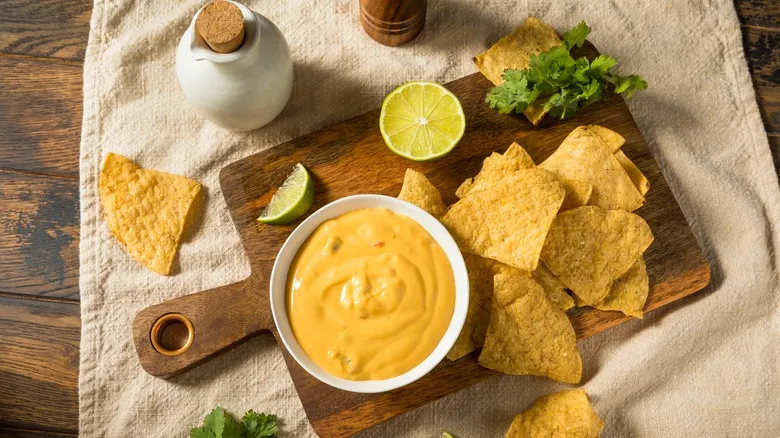
In Texas, queso is more than just a dip—it's a way of life. This gooey goodness is essential for gatherings, game days, happy hours, and Tex-Mex restaurants. Just remember, it’s not "cheese dip." In Texas, queso is almost its own food category: a hot, creamy mixture of melted cheese with a zesty flair.
The traditional recipe typically begins with Velveeta and Ro-Tel (a blend of tomatoes and green chilies). From there, the possibilities are endless—add jalapeños, onions, ground beef, chorizo, or even brisket. Some variations, like this smoky white queso dip, incorporate real cheeses such as American, cheddar, or Monterey Jack, blurring the lines between Texan queso and the more refined queso fundido. The outcome? A velvety, melty treat that’s perfect for scooping up with warm, crispy tortilla chips.
The appeal of queso lies in its adaptability. Use it as a dip, drizzle it over nachos, or smother your enchiladas in it. Legend has it that President Lyndon B. Johnson adored chiles rellenos drenched in queso from Austin's famous Matt's El Rancho so much that he had them flown to Washington, D.C.
Queso's origins in Texas date back to the early 20th century, blending Mexican culinary traditions with American ingredients. According to Lisa Fain's cookbook, "QUESO!," the Woman's Club of San Antonio published a "chile con queso" recipe in the 1920s, and Lady Bird Johnson's personal recipe was featured in The Washington Post in 1964. By the 1980s, Velveeta and Ro-Tel had become the go-to ingredients for queso, establishing it as a beloved staple for home cooks and restaurants throughout Texas.
Migas
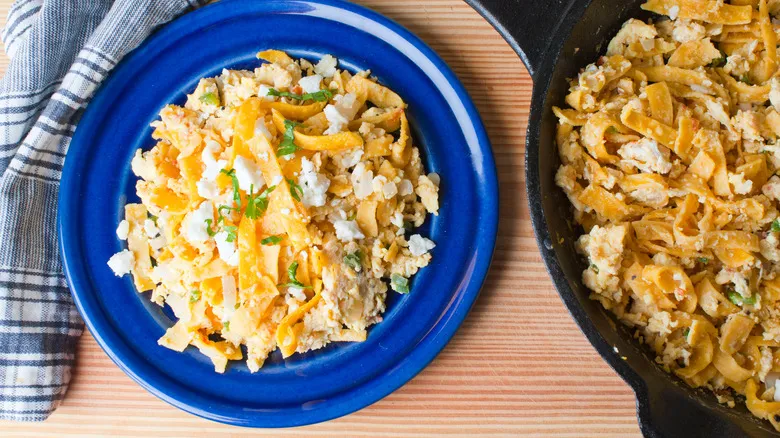
In Texas, if you're not indulging in a taco for breakfast, you're probably savoring migas (or, to truly blend in, a migas breakfast taco). This robust Tex-Mex staple elevates scrambled eggs by incorporating crispy tortilla strips, onions, tomatoes, and jalapeños. Many variations add cheese (because why not?), along with extras like chorizo and salsa for an added kick. The best part? Everything cooks together in a single pan, melding all those delightful textures and flavors into each bite.
Migas are favored for several compelling reasons. They're quick and simple to prepare, making them a popular option for hectic mornings and leisurely brunches. They also make excellent use of leftover tortillas and are highly customizable—spice them up, tone them down, make them vegetarian, or pile on the meat. The possibilities are endless.
The roots of migas can be traced back to Spanish, Portuguese, and Mexican cuisines, where various iterations of the dish have been enjoyed for centuries as a clever way to utilize stale bread. Traditional Spanish migas, for example, often combine bread crumbs with chorizo and grapes for a refreshing flavor contrast. Texans have crafted their own unique version, and now you can find migas on the menu of nearly every breakfast spot and diner across the state. Interested in making your own? Take inspiration from one of Texas' favorite taco chains, Tacodeli, and follow these steps to create delicious migas tacos.
Kolaches
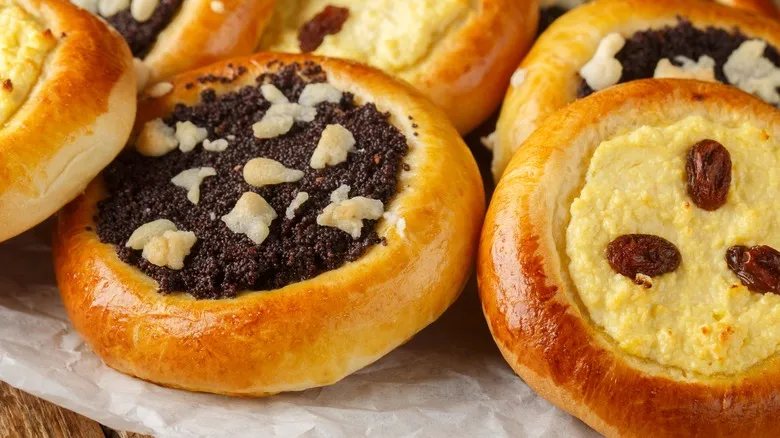
Kolaches (pronounced ko-LAH-chee) are delightful pastry treasures from the Lone Star State, often sweet and occasionally savory. These tasty treats trace their roots back to Czech immigrants who arrived in Texas during the 1800s, and they have since become a beloved breakfast item and snack throughout the region. A designated "Texas kolache trail" runs along I-35 between Dallas and Austin, allowing travelers to sample a variety of these delicious handmade pastries. If you can’t visit, you’ll find kolaches available in many places, including coffee shops and convenience stores.
The classic kolache features a sweet, yeast-based dough typically filled with fruit preserves like apricot or prune, poppy seeds, or sweetened cheese, as seen in this sweet kolache recipe. Over the years, Texans have added their own twist to this traditional treat, creating savory options filled with breakfast sausage and jalapeños, ham and cheese, or smoky bacon and eggs. There are even rolled versions similar to "pigs in a blanket," known by some as "klobasniky," though most Texans simply call all variations kolaches. Contemporary kolache menus showcase a wide array of creative and unique fillings. For instance, at Koala Kolache in Cypress, Texas, you can find everything from a Thanksgiving Dinner kolache to those filled with chicken enchiladas, crawfish étouffée, or bulgogi kimchi.
The appeal of kolaches lies in their simplicity and the comfort they provide, conjuring memories of home, family gatherings, and quaint local bakeries. In Texas, kolaches are more than just a treat; they represent the rich tapestry of flavors that make the state truly special.
Frito pie
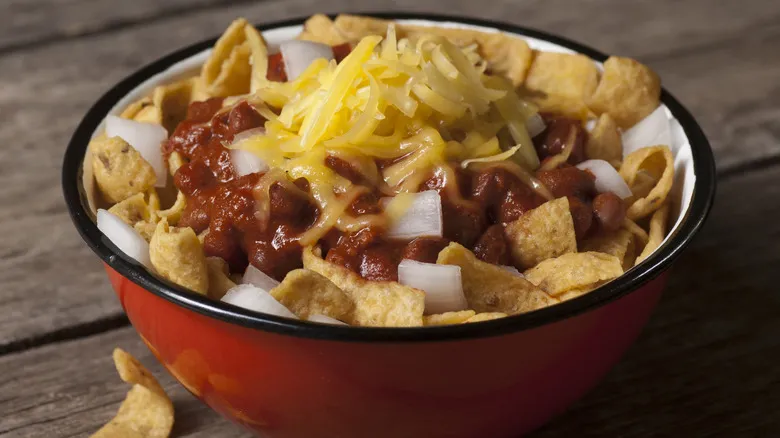
Although the late, iconic chef Anthony Bourdain referred to it as "warm crap in a bag," Frito pie continues to reign as a beloved comfort food in Texas. This wonderfully messy and simple dish begins with a base of crunchy Fritos corn chips, generously topped with spicy chili and a hearty sprinkle of shredded cheese, diced onions, and jalapeños. For those seeking an extra kick, a dollop of sour cream or a dash of hot sauce can be added. The result is a warm, gooey, and crunchy delight that hits all the right notes.
The origins of Frito pie are a topic of much debate, with several states vying for the title of its birthplace. Some attribute its creation to Katherine Doolin of Texas, whose husband, Charles Elmer Doolin, invented Fritos in the 1930s. Others point to a Woolworth's lunch counter in Santa Fe, New Mexico, during the 1960s as the original source, where a red chile version of Frito pie became a local favorite. In the Midwest, the dish has transformed into what is often referred to as a "walking taco," with all the ingredients mixed directly in the bag.
Regardless of its origins, one thing is certain: Frito pie is a cherished, comforting dish enjoyed nationwide. It's the ideal food for game days, county fairs, and tailgating events—anywhere a delicious, portable snack is needed. Plus, it's incredibly easy to prepare: just grab a bag of Fritos, add some chili, and you're all set!
Cowboy caviar

Is it a dip? A side dish? A taco topping? It’s all of those things! Cowboy Caviar is a standout on our list of iconic Texas dishes, offering a hearty yet light option that skips many traditional Texas staples like meat and cheese. Picture it as a zesty bean salad with a Tex-Mex flair: a vibrant, fresh dip loaded with black-eyed peas, black beans, corn, diced tomatoes, onions, and bell peppers. All of these ingredients are tossed together in a tangy vinaigrette, enhanced with a squeeze of lime juice and a sprinkle of cilantro, creating a flavor explosion in every bite.
The playful name is credited to Chef Helen Corbitt, who significantly influenced Texas's culinary landscape for four decades. She created the dish in 1940 and originally called it Texas Caviar, cleverly likening the beans to the more expensive roe of traditional caviar. Over time, the name evolved to Cowboy Caviar, but this salad has remained a cherished part of Texas cuisine, winning fans nationwide.
Ideal for scooping with tortilla chips or enjoying straight from the spoon, Cowboy Caviar is incredibly easy to prepare—just chop, mix, and serve. It’s also a fantastic way to showcase fresh, seasonal ingredients and can be easily customized. Try this Cowboy Caviar recipe at your next potluck or gathering, and watch it become a crowd favorite!
Armadillo eggs
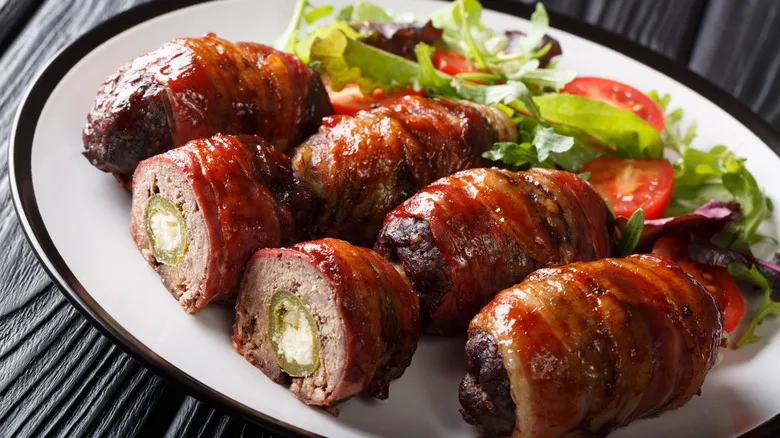
No armadillos are involved in creating these party favorites—just a mouthwatering blend of spicy, cheesy goodness. These bite-sized delights begin with the classic jalapeño popper—a jalapeño pepper hollowed out and filled with a creamy cheese mixture, typically cheddar or cream cheese, and sometimes enhanced with a touch of sausage for added flavor. The stuffed jalapeño is then usually wrapped entirely in bacon (though some opt for a breadcrumb coating), forming an egg-like shape, and baked or smoked until everything is perfectly cooked and the flavors meld together. The outcome? A smoky, spicy, cheesy treat that's crispy on the outside and gooey on the inside.
The exact origins of armadillo eggs are somewhat unclear, but they likely emerged from a blend of Southern cooking traditions and Tex-Mex influences, taking cues from the English Scotch egg. One of the earliest known mentions of armadillo eggs appeared in a 1972 article from the Victoria Advocate regarding an upcoming armadillo festival in Victoria, Texas.
Today, these cheesy, spicy morsels have become a beloved part of Texas culinary culture, captivating taste buds with their irresistible combination of heat, crunch, and gooey cheese. Whether at backyard barbecues or tailgate gatherings, armadillo eggs are always a crowd-pleaser and vanish quickly, proving that for Texans, everything is indeed better with bacon.
Funnel cake

Funnel cake is an essential treat at Texas carnivals, rodeos, and festivals. Picture a golden, crispy lattice of deep-fried dough, generously sprinkled with powdered sugar and served piping hot. The dough is funneled into sizzling oil, resulting in a light, crunchy delight that’s sweet, crispy, and just a bit chewy. While some like to top theirs with strawberries, chocolate sauce, or ice cream, the traditional powdered sugar version remains a favorite.
The origins of funnel cake can be traced back to Europe, influenced by German, French, and Middle Eastern culinary traditions. It was brought to America and popularized by German immigrants known as the Pennsylvania Dutch. This fluffy, crispy delicacy became a fairground favorite, beginning in Pennsylvania and spreading throughout the country.
Funnel cake has earned its place on our list of iconic Texas foods, largely thanks to Wanda "Fernie" Winter, the Funnel Cake Queen, who introduced her delightful version at the Texas State Fair in 1969, igniting a beloved tradition that continues to this day. Although Fernie passed away in 2021, her legacy endures through her family, who still serve the classic funnel cake along with creative variations. Today, funnel cake is more than just a dessert; it embodies the joy of Texas — a crispy, sweet, handheld snack that captures the essence of warm summer evenings, vibrant midways, bustling fairs, and dusty rodeos.
Want to skip the fair and whip up your own funnel cake? Check out this easy funnel cake recipe! Using buttermilk pancake mix as the main ingredient, it’s a delicious and simple way to enjoy this classic treat at home.
Pecan pie
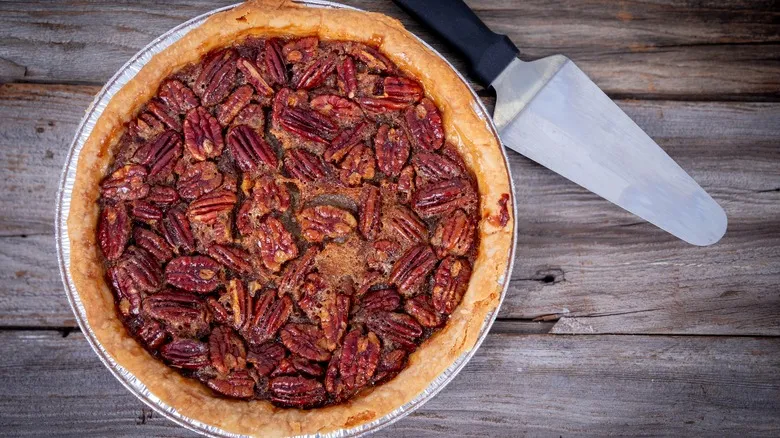
This beloved Texas dessert is not only a holiday favorite but also a timeless choice found on the dessert menus of diners across the region. The sweet and nutty pecan pie boasts a buttery, flaky crust filled with a rich, gooey blend of pecans, eggs, sugar, and corn syrup. Each bite provides a delightful crunch from the roasted pecans, perfectly complemented by the smooth, caramel-like filling that is sweet yet not overpowering. While it may seem simple, this pie offers an indulgent flavor experience.
Pecan pie's widespread appeal in Texas is no surprise, as pecans are the state's official nut and are indigenous to the area. The cultivation of pecans surged in the 19th century, thanks to Antoine, an enslaved individual who transformed pecan farming practices. The pie itself began to appear in Southern cookbooks in the late 1800s. Its ascent to national recognition in the early 1900s was propelled by the introduction of Karo Corn Syrup, which contributed to its signature gooey texture and helped establish it as a cherished American dessert by the 1940s.
Today, pecan pie embodies Texas tradition and evokes a warm, homey atmosphere that brings families together. Whether enjoyed at a backyard barbecue or a festive holiday gathering, this pie showcases the state's agricultural richness and Lone Star pride, making it a true favorite. Ready to whip up this Texas classic? Give this pecan pie recipe a try, and be sure to finish it off with a dollop of whipped cream or a scoop of vanilla ice cream.
Texas sheet cake
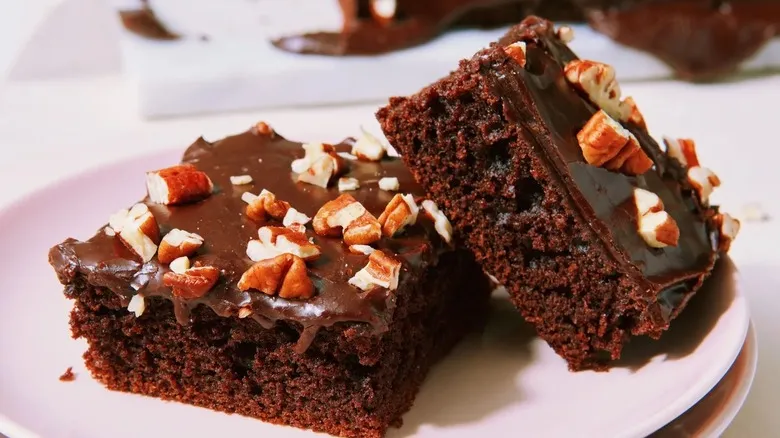
The Texas sheet cake is cherished for its straightforwardness, indulgent flavor, and capacity to serve a large group. This makes it a popular choice for potlucks, picnics, and family gatherings. Often referred to as "Texas funeral cake," it is known for providing comfort to many.
This cake requires no elaborate ingredients or intricate procedures—just essential pantry items like cocoa powder, buttermilk, and butter, similar to a classic chocolate cake recipe. You can also experiment with flavors, such as in this gochujang Texas sheet cake. Baked in a large, shallow pan, the cake emerges thin, moist, and ideal for slicing. What distinguishes Texas sheet cake is its warm, fudgy icing, which is poured over the hot cake, soaking into the surface for a gooey, brownie-like consistency. Traditionally, it is topped with crunchy chopped pecans.
The name of this cake is a topic of discussion. It may refer to its Texas-sized proportions—baked in a larger-than-normal sheet pan (10x15 or 12x18 inches)—or the pecan topping. A common myth that Lady Bird Johnson named the cake has been disproven. The recipe can be traced back to a 1936 chocolate cake recipe from Galveston, a 1957 entry in the Dallas Morning News, and even a 1967 Alabama cookbook. Its true rise to popularity occurred in the 1980s when it began appearing in regional cookbooks, cementing its status as a symbol of Southern hospitality.
Recommended
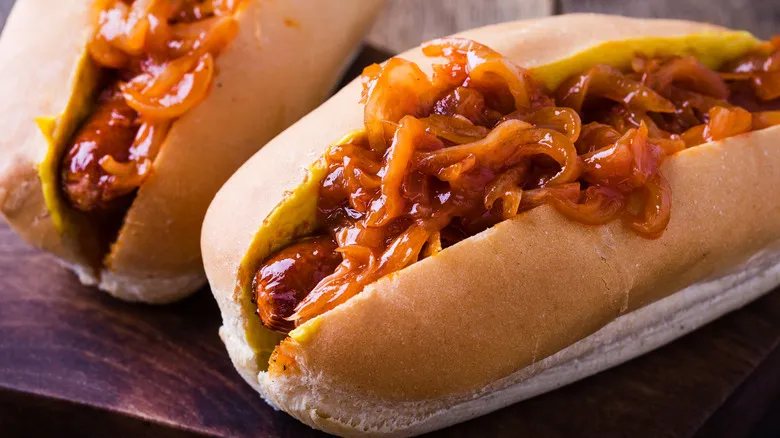
What Are 'Dirty Water' Hot Dogs?
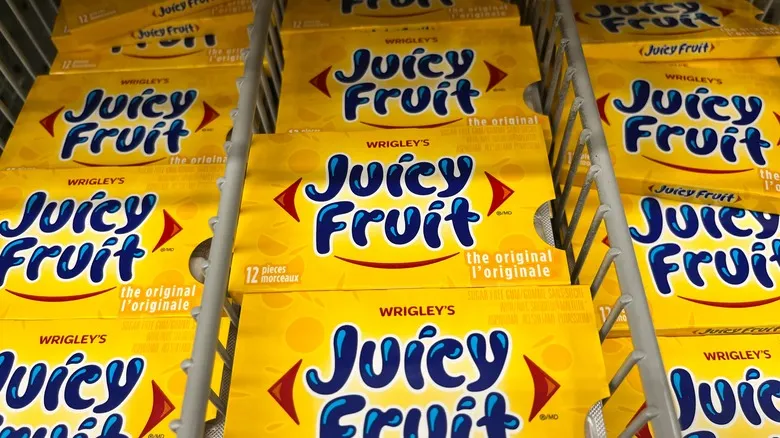
Juicy Fruit Gum Existed During The Gilded Age
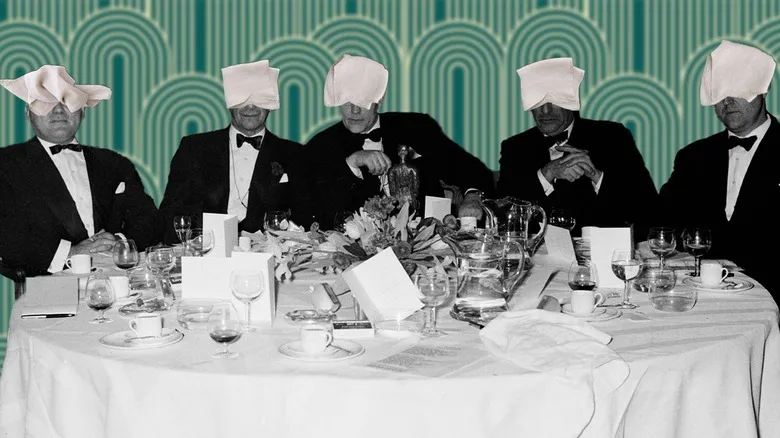
The Illicit French Delicacy That Has Diners Hiding Under Their Napkins
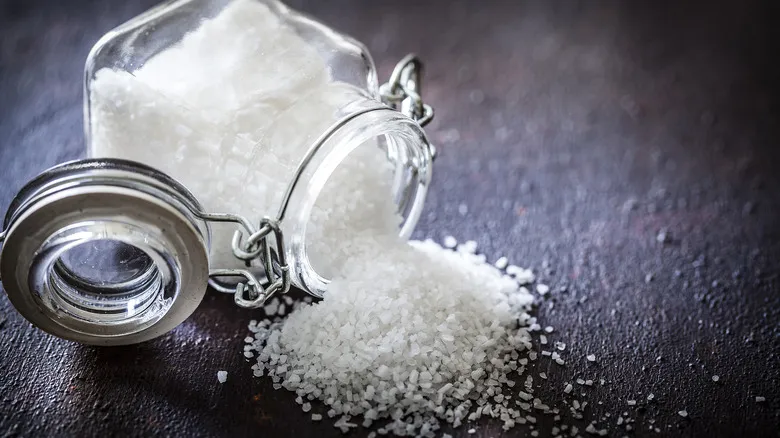
The Macabre Origin Of The Phrase 'Take It With A Grain Of Salt'
Next up

